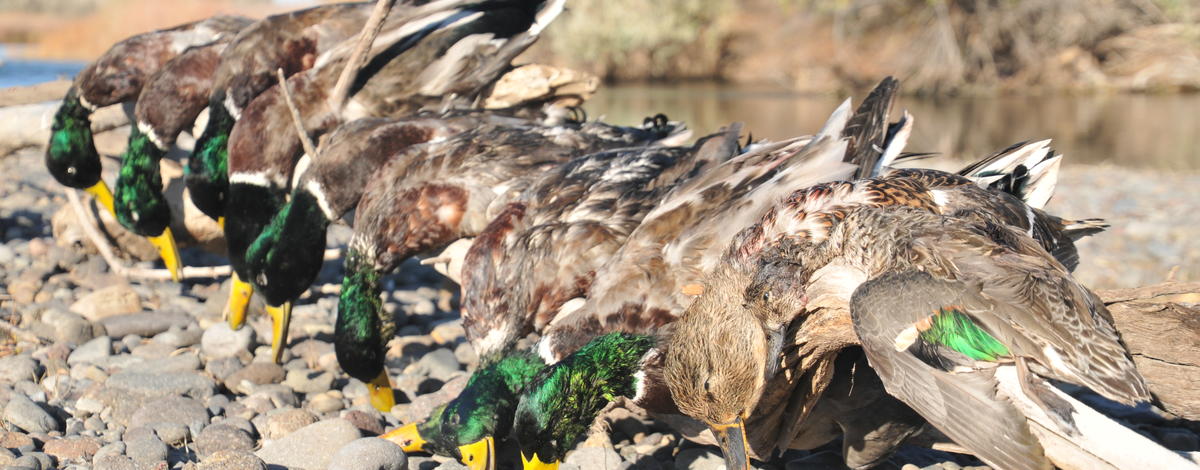Jump shooting ducks is an exciting way for anyone to hunt ducks and geese. It does not require expensive equipment, a dog (although handy), or having to wake up early in the morning.
All you need is:
- A “plugged” shotgun, or one capable of holding no more three shells total
- Idaho hunting license
- Migratory bird (HIP) permit
- Nontoxic shotgun shell (steel shot)
- Federal migratory bird stamp (all hunters 16 or older)
Here are some helpful steps that will help you be successful.
Do some scouting
Small creeks, ponds, river bottoms, or other bodies of water is where you will want to focus. Look for areas where ducks can be out of the water’s current, out of the wind, and next to banks near cover. Since we are focusing on jump shooting without a dog, you will want to look for water that you can easily navigate around to retrieve downed bird, or spots that allow for shots over dry land. Talking to friends and people at the local sporting goods store will give you a good start, but don’t feel like you need a “spot” to start with. Getting in the field and problem solving a plan is one of the most rewarding parts of hunting.
Hunt mid day
In the morning and evening the ducks are usually on the move flying to and from feeding areas. During the day, they will tend to loaf around on the water. On stormy and windy days, waterfowl will move to sheltered coves, river bends, and breaks. Jump shooting is usually best in the late morning and afternoon, while during the mornings and evenings the hunting is typically better with decoys. Hunting mid day will also mean you're less likely to disturb people hunting over decoys, or worse, sneaking up on their decoys (it happens).
Get close
Now that you’ve spotted birds you want to jump shoot, it’s time to plan your approach. Before moving in, look for terrain, brush or trees that can conceal your approach. Keeping focused on the objective, make sure you stay aware of where you will be going. As you get close - get low and go slow. You may need to crawl to get into position. Don’t rush, this is all about getting into position.
Knowing the birds will immediately fly away, you want to get within 20 yards of them, and closer is better. Keep your gun pointed in a safe direction, and be careful not to get any mud or debris in the barrel.
The Flush
Once you are in shooting distance, it’s time to plan your flush. It is best to stand up, or pick a short approach path. Once you are ready, quickly move to your spot, set your feet, and show yourself to the ducks. If you are in position and they still have not seen you, a quick yell will flush them.
The Shot
The anticipation of the stalk will be exciting, but try to remain calm. When the birds flush, choose a single bird and do not “flock shoot” in the area of a group of ducks. This will usually result in wounded birds, or missing all of them. Shooting at the body is usually best, but aiming for the head or neck area is even better so you don't shoot behind or beneath them. Flushing birds fly deceptively fast.
When choosing a duck, your first shot may want to be at a duck on the outside of the flock. This gives your shot a wider pattern and allows you to shoot a second, closer bird with your next shot. If a bird is wounded on the water, it is best to shoot it again rather than at another bird to prevent the potential of losing the wounded bird.
After your initial shots, you should mark where your downed birds are and reload. Your shot may also flush other ducks nearby, and you might get passing shots if they fly within range.
Some helpful (but not necessary) equipment:
- Camouflage clothing can help conceal your approach and limit the risk of the ducks seeing you before you can flush them
- Waterproof waders can help in both the approach to the ducks that may be in wet areas, and assist in retrieving downed ducks in water.
- Binoculars can help you find ducks that may be too far to see with the naked eye. It can also help you identify species of ducks or geese that may be in the group, and assist in how you will plan your sneak approach. It will also help avoid the potentially awkward situation of “jump shooting” another hunter’s decoys.
- A dog. As long as it doesn't disrupt your stalk, almost any dog can help you locate downed birds because they all have powerful noses.

